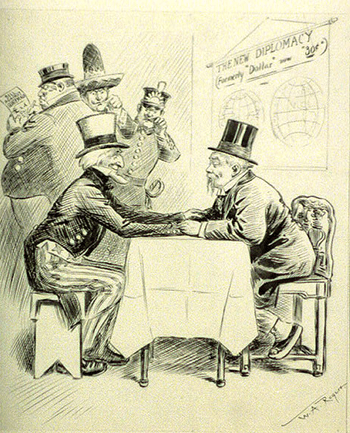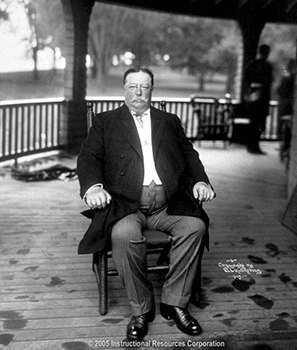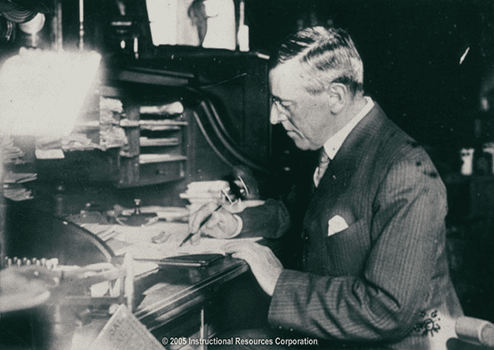Learn
Taft's Foreign Policy
Dollar Diplomacy
William Howard Taft's approach to American expansionism was slightly different than expected. Though a strong proponent of American imperialism, Taft preferred to utilize dollars instead of military might. The idea was that through financial investment in foreign nations, the United States would develop a scope of influence that would provide both stability to the foreign nation and economic opportunity for the United States. It would also allow the U.S. to generate influence in nations where other powers might already have an imperialistic presence.
Read Dollar Diplomacy to learn more about Taft's approach to foreign policy.


Wilson's Foreign Policy
Upon taking office, President Wilson remarked, "it would be the irony of fate if my administration had to deal chiefly with foreign affairs." Fate, it seems, had other plans for Wilson as many of his most pressing issues in office involved foreign affairs.
During his first term in office, Wilson sought to reduce American involvement overseas and tried to restore what he viewed as a loss of American credibility in the world. This isolation was ultimately interrupted by calls for help from Latin America and with the outbreak of war in Europe.

Wilson's Ideals
Upon taking office in 1913, President Wilson implemented a new approach to foreign policy that differed starkly from his predecessor.
Wilson was an anti-imperialist and a noninterventionist, so he opposed U.S. expansion into foreign nations and aimed to bring the United States back into its borders.
He opposed all forms of U.S. intervention in foreign nations, whether it be economic or military intervention.
One of his primary goals was to remove traces of U.S. intervention initiated under Roosevelt and Taft and to remain out of future conflicts.

U.S. Withdrawal
Wilson believed U.S. intervention in foreign nations achieved short-term goals but ultimately bred distrust and dislike of the United States.
While president, he reversed previous policies by:
- withdrawing financial support to China
- repealing the Panama Canal Tolls Act that exempted the U.S. from paying tolls at the canal
- signing the Jones Act of 1916 which promised independence for the Philippines once they formed a stable government
Foreign Intervention
Because Wilson's beliefs often guided his foreign policy decisions, his foreign policy was dubbed moral diplomacy.
Wilson's foreign policy decisions were also guided by the belief that democratic governments were superior to other forms of government. This belief ultimately inspired Wilson to intervene in foreign nations on multiple occasions. And by the end of his second term in office, Wilson's administration had intervened more in Latin America than either Roosevelt or Taft!
U.S. Involvement in Haiti
Background: Taft encouraged American investment in Haiti in an effort to provide financial assistance to the poor nation.
Wilson's Involvement: At the beginning of his term, Wilson withdrew much of U.S. involvement in Haiti, but many Americans continued to live there. Then, from 1914 to 1915 Haitians rebelled against their oppressive leader, so Wilson reluctantly sent troops to protect the Americans. After the rebellion, Wilson agreed to a treaty with Haiti to oversee finances and police the nation. The U.S. remained involved in the area for 19 years thereafter.
U.S. Involvement in Nicaragua
Background: U.S. was interested in Nicaragua's stability because of its location near the Panama Canal.
Wilson's Involvement: In 1911, Nicaragua asked for U.S. support and assistance with finances and American bankers and investors provided stability. In 1912, a revolution began and the U.S. sent troops to ensure stability in the area and continue to protect their interest in the Panama Canal area. The U.S. troops maintained a presence in Nicaragua for 13 years.
U.S. Involvement in Mexico
By the early 1900s, American investors were heavily involved in Mexico. They owned mines, railroads, oil, and many other resources. At the same time, Mexico was ruled by an oppressive leader. Mexican nationalism grew and a revolution eventually emerged.
Read Woodrow Wilson: Foreign Affairs to learn more about U.S. involvement in the Mexican Revolution. Start reading at Aggressive Moral Diplomacy and stop at Neutrality in World War I.